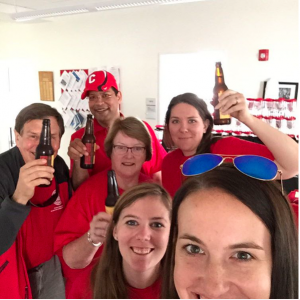Marty Sherman ’73, MHA ’75 has been an all-around volunteer leader for many years, having been an officer, director, or president of six Cornell alumni organizations, and having created and fostered many innovations along the way. Not content with having been an undergrad, a graduate student, and alumna, she has come full circle and is now on the faculty as a lecturer in the Sloan Program in Health Administration. Here is her story.
After I stepped down from the class presidency in 2013, I wanted to continue to volunteer for Cornell. Jim Mazza ’88, associate vice president for Alumni Affairs and Development (AA&D), suggested I look again at the Sloan Alumni Association.
At first I was a little doubtful. When I was in the program, it had been part of the business school, and the business professors and the health admin professionals in the Sloan Program did not get along at all. It got so bad that finally the Sloan Program people broke away and found a home within the Department of Policy Analysis and Management in the Hum Ec school. Ultimately this turned out to be a better fit. But the result was that a lot of program alumni like me had no real warm feeling from those days. Plus, being a graduate program, its alumni tended to have a stronger connection with their undergraduate alma maters than with Cornell.
Jim convinced me that my skills as a volunteer leader were needed there, so I applied to be on the Sloan Alumni Association board. As it happened, the SAA nominations chair was someone I knew and who had worked for my husband years ago. So I was soon elected to the board and became the secretary. It turned out that I was the only one on the board who had been a Cornell undergraduate, and who knew anything about how AA&D worked at Cornell. So I was able to fill in gaps in the other board members’ understanding of the Cornell environment.
The problems facing the SAA were quite similar to the ones I faced as class president. How do you get people to reconnect? How do you get them to financially support the program? I argued that you need to feed alumni positive news about the program on a continual basis, and you need to start work on the current program participants to give them a sense of Cornell as something more than just the location where the Sloan Program is housed.
In May 2014, I went for the first time to the Sloan Alumni weekend. A highlight of the weekend is the presentation by second-year students of their Capstone projects. (At the start of their second year, students are grouped into teams and undertake strategic planning and organizational projects for a healthcare organization. These are the Capstone projects.) Two things struck me: first, the teams were either all men or all women, and second, some of the projects were not very substantive. Brooke Hollis, the associate director of the program, overheard my comments and asked me to teach the Capstone course starting in the fall of 2014. I was stunned, because I have no teaching credentials, although I have many years’ experience as a hospital administrator and health care consultant. Nevertheless, my appointment went through quickly.
The syllabus I was given was quite weak. For example, there were no clear deliverables and no clear path as to how a Capstone project would connect with the 19 competencies that the Sloan Program wanted its graduates to have (e.g., negotiation skills, financial skills, knowledge of health law, ability to work in diverse teams, etc.). I worked with Brooke and Will White, the program director, to revamp the syllabus over the summer.
In the fall of 2014, I did not allow the students to self-select their teams. I did the selection so that each team had a cross-section of necessary skills and experience, as well as male/female balance. As a result, this year’s projects improved dramatically in quality, and addressed 16 of the 19 competencies. Next year’s projects will cover all of them.

Drawing on my years as a volunteer leader, I wanted to find a way to tie the current and future students closer to Cornell. One of the SAA board members came up with the idea of adapting the TV program “The Amazing Race” to the Cornell campus. So I researched the show and put together a race around the campus for first-year students. The students were paired off, and each team was assigned a second-year student to be the “documentor” to take pictures showing that the team found the location or object that was the subject of the current clue. Clues sent teams to the Sesquicentennial Grove to learn and sing the “Alma Mater,” to Sage Chapel to find three famous Cornellians who are buried there (and

why they’re important), to the Andrew D. White Library to find the autographed copy of the Kurt Vonnegut ’44 novel Slaughterhouse Five (the subject of the New Student Reading Project, a copy of which will be sent to all class dues payers who opted-in to receive it), to Uris Hall to find Rulloff’s brain, to the Dairy Bar to find five flavors named for Cornell things and have their picture taken by the milk bottle, and so on. I hoped that the race would take about three hours, but the first team finished in 46 minutes! The kids were very competitive, and they loved it. I think we’ve established a new tradition!
In short, I love working with the students, and I am having a ball doing this work that combines my healthcare administration experience with my volunteer leader experience. I would never have envisioned being on the Cornell faculty and doing what I am now doing. I strongly encourage classmates to check out the volunteer possibilities at the CUVolunteer system. Nominate yourself for something, if it matches your passion. Have fun!